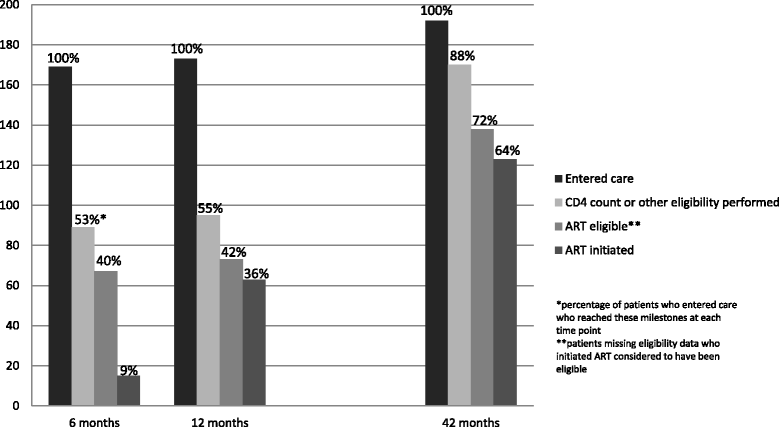Test site predicts HIV care linkage and antiretroviral therapy initiation: a prospective 3.5 year cohort study of HIV-positive testers in northern Tanzania
- PMID: 27646635
- PMCID: PMC5028933
- DOI: 10.1186/s12879-016-1804-8
Test site predicts HIV care linkage and antiretroviral therapy initiation: a prospective 3.5 year cohort study of HIV-positive testers in northern Tanzania
Abstract
Background: Linkage to HIV care is crucial to the success of antiretroviral therapy (ART) programs worldwide, loss to follow up at all stages of the care continuum is frequent, and long-term prospective studies of care linkage are currently lacking.
Methods: Consecutive clients who tested HIV-positive were enrolled from four HIV testing centers (1 health facility and 3 community-based centers) in the Kilimanjaro region of Tanzania as part of the larger Coping with HIV/AIDS in Tanzania (CHAT) prospective observational study. Biannual interviews were conducted over 3.5 years, assessing care linkage, retention, and mental health. Bivariable and multivariate logistic regression analyses were conducted to determine associations with early death (prior to the second follow up interview) and delayed (>6 months post-test) or failed care linkage.
Results: A total of 263 participants were enrolled between November, 2008 and August, 2009 and 240 participants not already linked to care were retained in the final dataset. By 6 months after enrollment, 169 (70.4 %) of 240 participants had presented to an HIV care and treatment facility; 41 (17.1 %) delayed more than 6 months, 15 (6.3 %) died, and 15 (6.3 %) were lost to follow up. Twenty-six patients died before their second follow up visit and were analyzed in the early death group (10.8 %). Just 15 (9.6 %) of those linked to care had started ART within 6 months, but 123 (89.1 %) of patients documented to be ART eligible by local guidelines had started ART by the end of 3.5 years. On multivariate analysis, male gender (OR 1.72; 95 % CI 1.08, 2.75), testing due to illness (OR 1.63; 95 % CI 1.01, 2.63), and higher mean depression scale scores (4 % increased risk per increase in depression score; 95 % CI 1 %, 8 %) were associated with early death. Testing at a community versus a hospital-based site (OR 2.89; 95 % CI 1.79, 4.66) was strongly associated with delaying or never entering care.
Conclusions: Nearly 30 % of the cohort did not have timely care linkage, ART initiation was frequently delayed, and testing at a hospital outpatient department versus community-based testing centers was strongly associated with successful care linkage.
Keywords: Africa; Antiretroviral therapy; HIV care continuum; HIV linkage to care; HIV testing; Health services accessibility; Mental health; Resource limited settings.
Figures


References
MeSH terms
Substances
Grants and funding
LinkOut - more resources
Full Text Sources
Other Literature Sources
Medical

